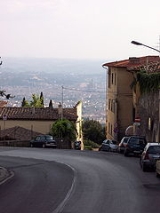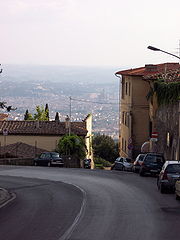
Fiesole
Encyclopedia



Comune
In Italy, the comune is the basic administrative division, and may be properly approximated in casual speech by the English word township or municipality.-Importance and function:...
of the province of Florence
Province of Florence
The Province of Florence is a province in the Tuscany region of Italy. It has an area of 3,514 sq. km and a population of 933,860 in 44 comuni....
in the Italian
Italy
Italy , officially the Italian Republic languages]] under the European Charter for Regional or Minority Languages. In each of these, Italy's official name is as follows:;;;;;;;;), is a unitary parliamentary republic in South-Central Europe. To the north it borders France, Switzerland, Austria and...
region of Tuscany
Tuscany
Tuscany is a region in Italy. It has an area of about 23,000 square kilometres and a population of about 3.75 million inhabitants. The regional capital is Florence ....
, on a famously scenic height above Florence
Florence
Florence is the capital city of the Italian region of Tuscany and of the province of Florence. It is the most populous city in Tuscany, with approximately 370,000 inhabitants, expanding to over 1.5 million in the metropolitan area....
, 8 km (5 mi) NE of that city. According to the 2003 census, its population was 14,100.
History

Etruscan civilization
Etruscan civilization is the modern English name given to a civilization of ancient Italy in the area corresponding roughly to Tuscany. The ancient Romans called its creators the Tusci or Etrusci...
confederacy, as may be seen from the remains of its ancient walls.
The first recorded mention on the town dates to 283 BC, when the town, then known as Faesulae, was conquered by the Romans
Roman Republic
The Roman Republic was the period of the ancient Roman civilization where the government operated as a republic. It began with the overthrow of the Roman monarchy, traditionally dated around 508 BC, and its replacement by a government headed by two consuls, elected annually by the citizens and...
. In pagan antiquity it was the seat of a famous school of augurs, and every year twelve young men were sent thither from Rome to study the art of divination. Sulla colonized it with veterans, who afterwards, under the leadership of Gaius Mallius, supported the cause of Catilina.
Fiesole was the scene of Stilicho
Stilicho
Flavius Stilicho was a high-ranking general , Patrician and Consul of the Western Roman Empire, notably of Vandal birth. Despised by the Roman population for his Germanic ancestry and Arian beliefs, Stilicho was in 408 executed along with his wife and son...
's great victory over the Germanic hordes of the Vandals
Vandals
The Vandals were an East Germanic tribe that entered the late Roman Empire during the 5th century. The Vandals under king Genseric entered Africa in 429 and by 439 established a kingdom which included the Roman Africa province, besides the islands of Sicily, Corsica, Sardinia and the Balearics....
and Suevi under Radagaisus
Radagaisus
Radagaisus was a Gothic king who led an invasion of Roman Italy in late 405 and the first half of 406. A commited Pagan, Radagaisus evidentily planned to sacrifice the Roman Senators to the gods and burn Rome to the ground. Radagaisus was executed after being defeated by the half-Vandal general...
in 406. During the Gothic War
Gothic War
Gothic War can refer to several periods of warfare between the Roman empire and the Goths, including:*Gothic War – Greuthungs and Thervings against the Eastern Roman Empire*Gothic War – Visigoths against the Western Roman Empire...
(536-53) the town was several times besieged. In 539 Justinus, the Byzantine general, captured it and razed its fortifications.
It was an independent town for several centuries in the early Middle Ages, no less powerful than Florence in the valley below, and many wars arose between them; in 1010 and 1025 Fiesole was sacked by the Florentines, before it was conquered by Florence in 1125, and its leading families obliged to take up their residence in Florence.
By the 14th century, rich Florentines had countryside villas in Fiesole, and one of them is the setting of the frame narrative of the Decameron, also Boccaccio wrote the poem "Ninfale fiesolano". Robert Browning also mentions "sober pleasant Fiesole" several times in his poem, Andrea del Sarto.
Main sights
- Remnants of EtruscanEtruscan civilizationEtruscan civilization is the modern English name given to a civilization of ancient Italy in the area corresponding roughly to Tuscany. The ancient Romans called its creators the Tusci or Etrusci...
walls. - Roman baths.
- Roman theatre.
- Palazzo Comunale (Town Hall) of the 14th century.
- The cathedral of Fiesole (Il Duomo), containing the shrine of St. RomulusRomulus of FiesoleSaint Romulus of Fiesole is venerated as the patron saint of Fiesole, Italy. Romulus was probably a local deacon, priest, or bishop of the 1st century....
, martyr, according to legend the first Bishop of Fiesole, and that of his martyred companions, also the shrine of St. Donatus of Fiesole. - The Badia or ancient cathedral of St. Romulus, built in 1028 by Bishop Jacopo Bavaro with materials taken from several older edifices, at the foot of the hill on which Fiesole stands, supposed to cover the site of the martyrdom of St. Romulus; it contains notable sculptures by Mino da Fiesole. The old cathedral became a BenedictineBenedictineBenedictine refers to the spirituality and consecrated life in accordance with the Rule of St Benedict, written by Benedict of Nursia in the sixth century for the cenobitic communities he founded in central Italy. The most notable of these is Monte Cassino, the first monastery founded by Benedict...
abbey, which passed into the hands of the regular canons of Lateran. It once possessed a valuable library, long since dispersed. The abbey was closed in 1778. - The room in the bishop's palace where St. Andrew Corsini lived and died.
- The little church of the Primerana in the cathedral square, where the same saint was warned by Our Lady of his approaching death. Built in 996 and further expanded in medieval times, has maintained the Gothic presbytery from that period. It received a new façade in the late 16th century, with graffito decoration by Ludovico ButiLudovico ButiLudovico Buti was an Italian painter, active mostly in Florence.Belonging to the late-Mannerist period, he worked along with more famous figures as Alessandro Allori, Bernardino Poccetti or Santi di Tito on large projects, including the decoration of certain ceilings of the Uffizi and the Grand...
. The interior, on a single hall, has a 13th century panel portraying Madonna with Child. In the transept are two marble bas-reliefs by Francesco da SangalloFrancesco da SangalloFrancesco da Sangallo was an Italian High Renaissance sculptor, the son of the architect and sculptor Giuliano da Sangallo....
, and a terracotta from Andrea della Robbia's workshop. - The church of S. Alessandro, with the shrine of St. Alexander, bishop and martyr.
- The monastery of S. Francesco on the crest of the hill, with the cells of St. Bernardine of Siena and seven Franciscan Beati.
- San Girolamo, the home of Venerable Carlo dei Conti Guidi, founder of the Hieronymites of Fiesole (1360).
- San DomenicoConvent of San Domenico, FiesoleThe Convent of San Domenico is a Dominican convent in Fiesole, Italy, situated between the hill of Fiesole and the suburbs of Florence. It was founded in 1406 and completed in 1435 on the initiative of Giovanni Dominici and the bishop of Fiesole, Jacopo Altoviti, both of them monks at the Basilica...
, the novice-home of Fra AngelicoFra AngelicoFra Angelico , born Guido di Pietro, was an Early Italian Renaissance painter described by Vasari in his Lives of the Artists as having "a rare and perfect talent"...
and of St. Antoninus of Florence. - Fontanelle, a villa near S. Domenico, where St. Aloysius came to live in the hot summer months, when a page at the court of Grand Duke Francesco de' Medici.
- Villa Medici in FiesoleVilla Medici in FiesoleThe Villa Medici is a patrician villa in Fiesole, Tuscany, Italy, the fourth oldest of the villas built by the Medici family. It was built between 1451 and 1457.-External links:*...
. - Villa Le BalzeVilla Le BalzeVilla Le Balze is a garden villa in Fiesole, Tuscany, central Italy. The Villa is owned by Georgetown University and hosts year round study abroad students. Planned in 1911 by Cecil Pinsent for American Charles Augustus Strong, it was built in a tight space along the Tuscan hills overlooking the...
- Villa PalmieriVilla Palmieri, FiesoleVilla Palmieri is a patrician villa in the Fiesole, central Italy, that overlooks Florence. The villa's gardens on slopes below the piazza S. Domenico of Fiesole are credited with being the paradisal setting for the frame story of Boccaccio's Decameron....
- Villa SchifanoiaVilla Schifanoiathumb|250px|The garden.Villa Schifanoia is a villa in Fiesole, Tuscany, central Italy, near the boundary with the communal territory of Florence.-History:...
. - Fonte Lucente, where a miraculous crucifix is greatly revered.
- Castello di Vincigliata
In the neighbourhood are:
- Monte Senario, the cradle of the Servite OrderServite OrderThe Servite Order is one of the five original Catholic mendicant orders. Its objects are the sanctification of its members, preaching the Gospel, and the propagation of devotion to the Mother of God, with special reference to her sorrows. The members of the Order use O.S.M. as their post-nominal...
, where its seven holy founders lived in great austerity and were cheered at their death by the songs of angels - S. Martino di Mensola, with the body of St. Andrew, an Irish saint, still incorrupt.
Famous residents
- Francesco LandiniFrancesco LandiniFrancesco degli Organi, Francesco il Cieco, or Francesco da Firenze, called by later generations Francesco Landini or Landino was an Italian composer, organist, singer, poet and instrument maker...
(c.1325–1397), composer, singer, poet, organist and instrument maker - Lorenzo MonacoLorenzo MonacoLorenzo Monaco was an Italian painter of the late Gothic-early Renaissance age.-Biography:...
(1370–1424), painter - the greatest name associated with the city is that of Fra AngelicoFra AngelicoFra Angelico , born Guido di Pietro, was an Early Italian Renaissance painter described by Vasari in his Lives of the Artists as having "a rare and perfect talent"...
or Blessed Giovanni Angelico, called da Fiesole (1387–1455). His baptismal name was Guido, but entering the convent of the Reformed Dominicans at Fiesole, he took Giovanni as name in religion; the surname Angelico 'angelic' was afterwards given to him in allusion to the beauty of his works and purity of spirit. - Mino da FiesoleMino da FiesoleMino da Fiesole , also known as Mino di Giovanni, was an Italian sculptor from Poppi, Tuscany. He is noted for his portrait busts.-Career:...
, Florentine sculptor (c.1429—1484) and painter - Andrea BarzagliAndrea BarzagliAndrea Barzagli, Ufficiale OMRI is an Italian World Cup-winning footballer who plays as a defender for Serie A club Juventus.- Club career :...
, soccer player, member of the 2006 Italian World Cup champion team. - Gertrude SteinGertrude SteinGertrude Stein was an American writer, poet and art collector who spent most of her life in France.-Early life:...
and Alice B. ToklasAlice B. ToklasAlice B. Toklas was an American-born member of the Parisian avant-garde of the early 20th century.-Early life, relationship with Gertrude Stein:...
spent their summers in Fiesole before the First World War. - Frank Lloyd WrightFrank Lloyd WrightFrank Lloyd Wright was an American architect, interior designer, writer and educator, who designed more than 1,000 structures and completed 500 works. Wright believed in designing structures which were in harmony with humanity and its environment, a philosophy he called organic architecture...
for some time in 1910 - Caterina BuenoCaterina BuenoCaterina Bueno was an Italian singer and folk music historian.-Biography:Starting in the 1960s, her research and performances of Italian folk songs, particularly those of Tuscany, are credited to bringing a new awareness of Italian folk music.Bueno was born in San Domenico di Fiesole to her...
(1943–2007), singer and folk music historian

